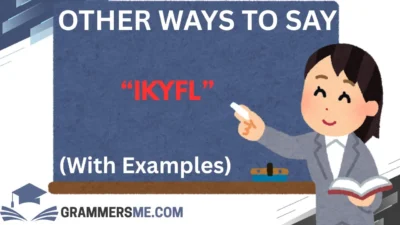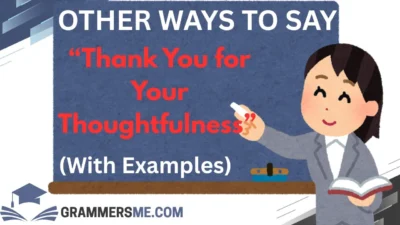Sometimes, it’s not just what you say, but how you say it that leaves a lasting impression. Whether you’re navigating a professional setting, responding to a colleague, or acknowledging a friend’s helpful insight, the phrase “Thank you for the clarification” might start to feel overused.
Finding warmer, more personal, and thoughtful ways to express appreciation can make your communication more genuine and engaging. This article offers 30 heartfelt alternatives, each crafted to help you connect more deeply and show your appreciation with care and clarity.
What Does “Thank You for the Clarification” Mean?
Meaning: This phrase is commonly used to express gratitude when someone explains or simplifies something you didn’t understand clearly at first.
Explanation: It shows that you value the effort someone took to make things clearer. It’s polite, straightforward, and commonly used in professional and academic environments.
Tone: Respectful, appreciative, and neutral.
Is It Professional/Polite to Say “Thank You for the Clarification”?
Yes, it is both professional and polite. It’s a safe, well-accepted phrase in emails, meetings, and conversations. However, using different variations depending on context can help keep your language fresh, warm, and less robotic.
1. I Appreciate the Explanation
Meaning: You’re grateful for the effort taken to explain something.
Explanation: It’s slightly more personal than the original phrase, using “appreciate” to convey genuine warmth.
Example: “I appreciate the explanation—it really helped me understand the process better.”
Best Use: In casual or professional emails where a little more warmth is welcome.
Not Use: Avoid in highly formal documents or legal communications.
Tone: Appreciative, respectful, and kind.
2. Thanks for Clearing That Up
Meaning: You’re thankful that someone resolved your confusion.
Explanation: This is a friendly, conversational way to show gratitude.
Example: “Thanks for clearing that up—I wasn’t quite sure what the timeline was.”
Best Use: In team chats, Slack messages, or casual meetings.
Not Use: In formal business correspondence.
Tone: Casual, friendly, and lighthearted.
3. That Makes Much More Sense Now – Thanks!
Meaning: You’re saying the new information helped you understand better.
Explanation: This alternative directly acknowledges the impact of the clarification.
Example: “That makes much more sense now—thanks for taking the time to walk me through it.”
Best Use: When someone has spent extra effort to explain something in detail.
Not Use: When the clarification was very minor.
Tone: Warm, conversational, and appreciative.
4. I’m Grateful for the Insight
Meaning: You’re expressing sincere thanks for the new understanding.
Explanation: This is a slightly more formal and heartfelt way to say thanks.
Example: “I’m grateful for the insight—it helped me approach the task with more clarity.”
Best Use: In professional settings where you want to be thoughtful and respectful.
Not Use: In quick, informal back-and-forths.
Tone: Professional, reflective, and respectful.
5. Thanks for Taking the Time to Explain
Meaning: You’re acknowledging the person’s effort and time.
Explanation: This phrase highlights appreciation for the speaker’s patience.
Example: “Thanks for taking the time to explain the new policy in detail.”
Best Use: When someone has gone out of their way to help you understand.
Not Use: For brief or obvious clarifications.
Tone: Warm, appreciative, and considerate.
6. That Helped Me a Lot—Thanks!
Meaning: You’re recognizing the value of the clarification.
Explanation: This is a great way to affirm the explanation was effective.
Example: “That helped me a lot—thanks for explaining the difference!”
Best Use: When you want to acknowledge the impact of the clarification.
Not Use: In situations that require formal phrasing.
Tone: Friendly, grateful, and sincere.
7. Appreciate the Clarity
Meaning: You’re thankful for someone making something clear.
Explanation: Short, professional, and to the point—yet still appreciative.
Example: “Appreciate the clarity—it really streamlined things for me.”
Best Use: Emails, project discussions, and reports.
Not Use: When a more emotional or heartfelt tone is needed.
Tone: Neutral, clean, and efficient.
8. Thanks for Helping Me Understand
Meaning: You’re grateful for someone’s role in your understanding.
Explanation: Adds a personal touch that acknowledges mutual communication.
Example: “Thanks for helping me understand how it fits into the overall strategy.”
Best Use: In collaborative environments and learning settings.
Not Use: When addressing large groups or formal reports.
Tone: Appreciative and sincere.
9. That Was Super Helpful—Thanks!
Meaning: You’re expressing genuine appreciation for the clarity.
Explanation: Energetic and friendly, this phrase is good for peer communication.
Example: “That was super helpful—thanks for breaking it down!”
Best Use: In friendly work teams, chats, and casual environments.
Not Use: In professional emails to higher-ups.
Tone: Upbeat, informal, and warm.
10. Got It—Thanks for Explaining!
Meaning: You understand now and appreciate the help.
Explanation: Confident and efficient while still showing gratitude.
Example: “Got it—thanks for explaining the report changes.”
Best Use: Quick replies, task confirmations.
Not Use: When a more detailed response is required.
Tone: Concise, casual, and clear.
11. That Explanation Was Really Useful – Thank You
Meaning: You’re expressing appreciation for a helpful breakdown.
Explanation: This phrase emphasizes the usefulness of the clarification and conveys that it made a difference.
Example: “That explanation was really useful—thank you for going into detail.”
Best Use: When someone offers a thoughtful or in-depth explanation.
Not Use: For very brief or obvious clarifications.
Tone: Warm, reflective, and professional.
12. I See What You Mean Now – Appreciate It
Meaning: You’ve gained understanding and want to acknowledge that.
Explanation: This is a friendly way to acknowledge clarity and express gratitude.
Example: “Ah, I see what you mean now—appreciate it!”
Best Use: In back-and-forth conversations or when problem-solving.
Not Use: When you need more formal or structured communication.
Tone: Conversational, appreciative, and collaborative.
13. Thanks for the Insightful Breakdown
Meaning: You’re thankful for a detailed and insightful clarification.
Explanation: This phrasing highlights both the clarity and the quality of the explanation.
Example: “Thanks for the insightful breakdown—it really helped me understand the project’s direction.”
Best Use: In thoughtful or strategic discussions.
Not Use: In extremely casual conversations.
Tone: Professional, thoughtful, and appreciative.
14. Really Helpful—Thanks for Taking the Time
Meaning: You’re acknowledging the helpfulness and the effort made.
Explanation: It conveys appreciation while being mindful of the person’s time.
Example: “That was really helpful—thanks for taking the time to clarify it.”
Best Use: After meetings, training, or detailed responses.
Not Use: For minor clarifications that didn’t require much effort.
Tone: Warm, considerate, and polite.
15. Thanks for Making That Clear
Meaning: You’re thanking someone for bringing clarity.
Explanation: Short and to the point, this version is versatile and professional.
Example: “Thanks for making that clear—I understand the next steps now.”
Best Use: Email replies or meeting follow-ups.
Not Use: When you want to show more emotion or depth.
Tone: Neutral, appreciative, and efficient.
16. Now It All Adds Up – Thanks!
Meaning: You’re acknowledging that things make sense now because of the clarification.
Explanation: Adds a natural tone to your expression of gratitude.
Example: “Now it all adds up—thanks for walking me through it.”
Best Use: When someone connects the dots for you.
Not Use: In very formal communications.
Tone: Friendly, appreciative, and informal.
17. Thanks for Walking Me Through That
Meaning: You’re thankful for being guided step-by-step.
Explanation: Especially useful when someone has taken time to explain a process.
Example: “Thanks for walking me through that. It’s much clearer now.”
Best Use: In training, onboarding, or mentoring contexts.
Not Use: For small clarifications.
Tone: Grateful, warm, and thoughtful.
18. That Clarified a Lot—Thanks!
Meaning: The explanation removed confusion and brought clarity.
Explanation: This alternative is straightforward and validating.
Example: “That clarified a lot—thanks for being so thorough.”
Best Use: When previously unclear information becomes easier to understand.
Not Use: When minimal clarification was needed.
Tone: Honest, appreciative, and professional.
19. You Explained That Perfectly – Thanks So Much
Meaning: You’re complimenting both the clarity and the communication skills.
Explanation: Makes the person feel good about how well they explained things.
Example: “You explained that perfectly—thanks so much for your help.”
Best Use: When someone went above and beyond to make things understandable.
Not Use: When you need to keep things strictly formal.
Tone: Warm, personal, and appreciative.
20. Appreciate the Detailed Response
Meaning: You’re thankful for a thorough and thoughtful explanation.
Explanation: This is a more formal and respectful way to acknowledge clarity.
Example: “Appreciate the detailed response—it cleared up my confusion.”
Best Use: In business emails, customer service responses, or technical clarifications.
Not Use: In short, friendly chats.
Tone: Professional, respectful, and sincere.
21. Thanks for Breaking That Down
Meaning: You’re thankful that someone simplified something complex.
Explanation: Great for when someone explains a complicated topic in simpler terms.
Example: “Thanks for breaking that down—it made the whole thing a lot easier to understand.”
Best Use: In technical or analytical contexts.
Not Use: When referring to something already simple.
Tone: Friendly, clear, and relaxed.
22. That Was a Big Help – Thank You
Meaning: You’re saying the clarification was valuable.
Explanation: Emphasizes the impact the explanation had.
Example: “That was a big help—thank you for the insight.”
Best Use: When someone’s input really made a difference.
Not Use: When clarification was minimal or expected.
Tone: Honest, warm, and expressive.
23. Thanks for Making It Easier to Understand
Meaning: You’re thankful that someone simplified things for you.
Explanation: This shows appreciation for how someone communicated.
Example: “Thanks for making it easier to understand—I was completely lost before.”
Best Use: In learning environments or when new to a subject.
Not Use: In rigid formalities.
Tone: Friendly, sincere, and appreciative.
24. I Get It Now – Thanks So Much!
Meaning: You’re confirming understanding and expressing gratitude.
Explanation: Clear and cheerful, this version feels conversational and human.
Example: “I get it now—thanks so much for your patience!”
Best Use: In friendly chats or mentoring conversations.
Not Use: In formal reports or legal documents.
Tone: Light, casual, and genuine.
25. That Cleared Up My Confusion – Thank You
Meaning: You’re being direct about what the explanation helped fix.
Explanation: Honest and appreciative, without being overly formal.
Example: “That cleared up my confusion—thank you for explaining it so clearly.”
Best Use: When you want to show relief or progress in understanding.
Not Use: In brief communications.
Tone: Sincere, grateful, and clear.
26. I’m Thankful for the Clarification
Meaning: A more formal and intentional version of the original.
Explanation: Emphasizes sincerity and formality.
Example: “I’m thankful for the clarification—it helped me avoid a major mistake.”
Best Use: Formal emails or serious discussions.
Not Use: In quick or casual exchanges.
Tone: Polished, thoughtful, and respectful.
27. You Made That So Much Clearer
Meaning: A compliment and expression of gratitude all in one.
Explanation: This emphasizes how effectively the person explained something.
Example: “You made that so much clearer—I really appreciate your help.”
Best Use: When someone has a strong communication style.
Not Use: When the explanation was just a minor tweak.
Tone: Warm, complimentary, and appreciative.
28. Thank You for the Extra Context
Meaning: You’re acknowledging that additional information made things clearer.
Explanation: A great way to recognize someone’s effort in giving background info.
Example: “Thank you for the extra context—it really helped everything click.”
Best Use: In workplace discussions or project meetings.
Not Use: When the clarification was very brief.
Tone: Professional, respectful, and thoughtful.
29. I Truly Appreciate Your Explanation
Meaning: You’re emphasizing the depth of your gratitude.
Explanation: “Truly” adds sincerity and emotional warmth.
Example: “I truly appreciate your explanation—it showed a lot of patience and care.”
Best Use: In situations that required time, patience, or effort.
Not Use: When trying to keep the tone light or brief.
Tone: Heartfelt, warm, and respectful.
30. That Cleared Things Up Nicely – Many Thanks!
Meaning: You’re saying the explanation was helpful and satisfying.
Explanation: Cheerful and polite, this is a great way to end a discussion on a positive note.
Example: “That cleared things up nicely—many thanks!”
Best Use: Closing thoughts in meetings or emails.
Not Use: When a more serious or somber tone is needed.
Tone: Gracious, upbeat, and positive.
Conclusion
Finding the right words to say “Thank you for the clarification” can make all the difference in how your message is received. Whether you’re in a professional setting, casual conversation, or learning environment, using more thoughtful, warm, and clear alternatives can make your gratitude stand out. As someone who communicates across various platforms and tones, I’ve learned that a bit of personal touch goes a long way. Try a few of these options out—you might just notice your conversations becoming more engaging and appreciated.
FAQs
1. Is it okay to say “Thanks for clarifying” in a professional setting?
Yes, it’s polite and acceptable, though using variations like “Appreciate the clarity” can sound more polished.
2. What if I didn’t fully understand even after the explanation?
Try saying, “Thanks for the explanation—could we go over it once more?” That way, you’re still polite while asking for further help.
3. Can I use these phrases in emails?
Absolutely. Many of these alternatives work well in emails, especially ones like “Appreciate the detailed response” or “Thank you for the extra context.”
4. How can I make my gratitude sound more sincere?
Use words like “truly,” “really,” or “grateful” to add depth and emotion to your thank-you.
5. Are these alternatives suitable for non-native English speakers?
Yes! Most of these are simple, clear, and widely understood. They’re great for anyone looking to sound more natural and warm in English.



